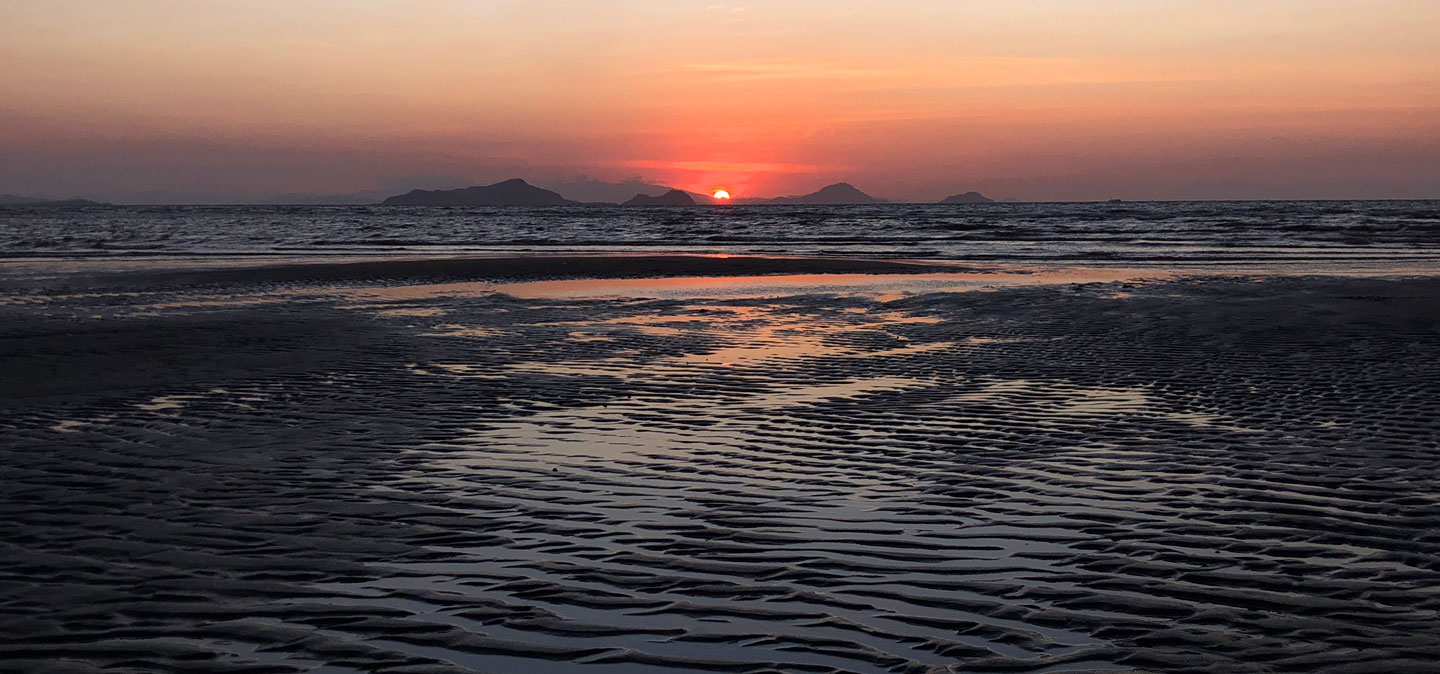2021 Most Wanted Tour 2 Recap
Posted: January 23, 2022
August 5-9, 2021 - From Salt Lake City, Utah
It’s not uncommon for a birding tour to have some adversity. Be it the weather, uncooperative birds, traffic noise or any number of other things that can come up. Over the course of the past 5 years our Most Wanted Tours have for the most part run super smoothly. Leading up to our 2nd Most Wanted Tour of 2021 we had our first major itinerary issues in 10 tours. If you read my previous recap about our 2021 Himalayan Snowcock Expedition you find out that at the end of our tour, flash floods caused mudslides that closed Lamoille Canyon in the Ruby Mountains. This canyon is
THE best location in the range to access and see Himalayan Snowcock. While I crossed my fingers that maybe the canyon would open so that we could still make a run at the birds, that was not the case—it remained closed for a month and a half before reopening. With the knowledge that the snowcock was out, one tour member opted to cancel, leaving us with a group of 6 that still wanted to try for everything else. With that in mind I made some quick changes to our itinerary and we got right to birding.

This
Swainson's Hawk eating was an incredible sight!
The tour would start off as usual looking for Black Swift and Flammulated Owl, followed up with a visit to the Sage and Juniper specialists habitats near SLC. But instead of going to Nevada, we stayed in Utah for some high elevation birding that afternoon, before birding the Great Salt Lake on day 3 and continuing to Idaho for Cassia Crossbill. Day 4 was spent birding round Twin Falls and birding a shorebird hotspot we had never visited before, before wrapping things up on day 5 with more birding around Twin Falls and the Great Salt Lake on the way back to the airport. Species wise we actually saw more birds than our normal Most Wanted Tour, but obviously no Snowcock.

The summer of the
Tundra Swan continued in Salt Lake
On August 5th I picked our group up from the airport and headed east to Millcreek Canyon to pick up
Tundra Swan for the last time this summer. The birds that had been present were still there, and actually continued through the writing of this post in January 2022. We got the swans and found a very quiet canyon on this summer afternoon. The breeders had stopped being active and while we managed
Cordilleran Flycatcher and
Warbling Vireo, it was otherwise quiet. A surprise
American Dipper along the creek was a great addition to get things started though!

Swift Watching at Bridal Veil Falls
After dinner we headed south for Black Swift. Our usual location in Salt Lake had been a dud as of late so we took our chances at Bridal Veil Falls where for the first time in my 25+ years birding this Sumer had been reliable for these birds. Tonight, at least
2 Black Swifts were circling overhead, but not nearly as cooperative as some other nights this summer. We also added
Osprey and
Peregrine Falcon here while we waited on the sun to set.
We made our way up in elevation for owls. I warned the group that things had been quite difficult in recent trips here as the birds were already quiet for the season, and we may not have a good opportunity tonight. As it turned out, that was the case. We heard 5
Flammulated Owl audibles and had a bird fly through the headlights, but that was it. Not wanting to be out all night, we called it early, knowing we would have another chance in Idaho.
 Peregrine Falcon
Peregrine Falcon leaving the water hole
Early the next morning we visited the desert an hour outside of Salt Lake City. Again, things were quieter than normal. We did manage to track down a
Gray Vireo and a pari of
Gray Flycatchers. Additionally we had a couple cooperative
Juniper Titmouse,
Woodhouse’s Scrub-Jay, and
Loggerhead Shrike. Recent rains had created a pool where one typically forms each spring. Much to our surprise a
Peregrine Falcon was sitting at the waters edge as we drove past!
 Golden Eagle
Golden Eagle on a power tower

Richard showing off his
Golden Eagles shirt
Having a full day to bird in Utah I took the group through a tour of some agricultural areas. Right away we had a pair of cooperative
Golden Eagles. It was a fitting bird given 2 members of the group worked at Tennessee Tech University—the Golden Eagles! Richard even happened to be wearing a Golden Eagles shirt—a fortuitous coincidence!
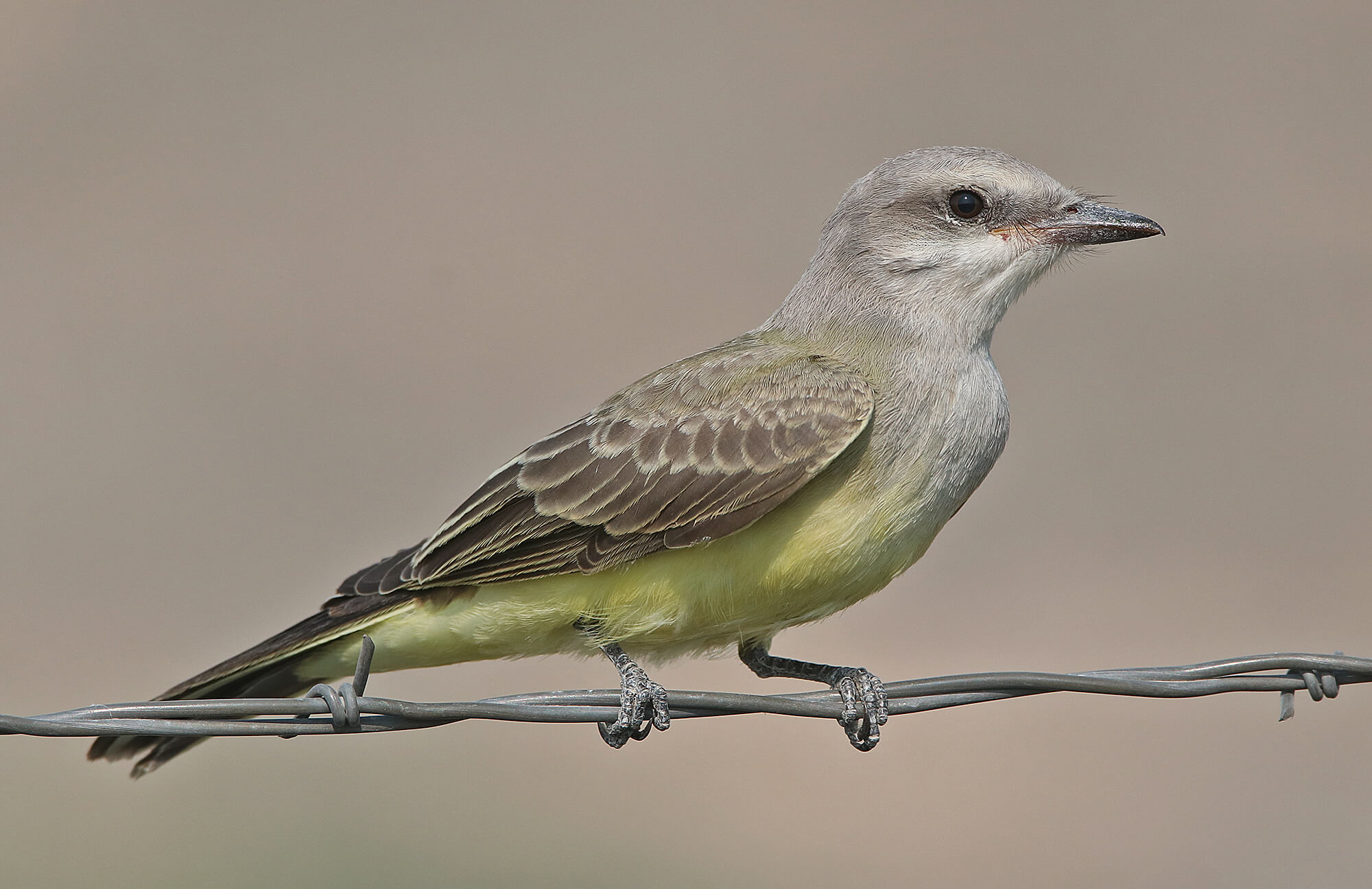 Western Kingbird
Western Kingbird posing next to the road
Our drive through the farm fields turned up good numbers of
Western Kingbird,
Lark Sparrows,
Mountain Bluebirds,
Western Meadowlarks, and
Swainson’s Hawks. Eventually after eating up most of the morning we headed back to Salt Lake for lunch and short afternoon break before heading to higher elevation to escape the heat and see what local montane birds we could find since we wouldn’t be getting to treelike in Nevada!

The unexpected
White-winged Crossbill
The plan was to visit some hummingbird feeders and make our way through a mixed aspen and coniferous forest. As we started walking I heard a whirling trill and immediately perked up, I told the group to come with me, there were
White-winged Crossbills singing ahead! We found the birds quickly and realized there were 5 birds moving about the tops of the trees feasting on the cones. We spend 20 minutes taking photos, making recording and videos and enjoying the great looks at these birds we don’t normally see on tour since they are generally rare in Utah

Young
Orange-crowned Warbler in a baby Aspen
We continued walking after the crossbill show adding
Red Crossbill,
Olive-sided Flycatcher, and a cooperative
Red-named Sapsucker. The birding was pretty good despite being quieter than usual. One interesting thing was the lack of hummingbirds. The feeders we visit had a lone
Rufous Hummingbird visiting and nothing else! Super weird for this time of year

Young
Warbling Vireo waiting for its feeding
The rest of our loop turned up a lot of young birds. We saw several young
Orange-crowned Warblers as well a few
Warbling Vireos, including one bird interacting with a parent that we were able to watch for several minutes. Cooperative
Hermit Thrush,
Dark-eyed Junco,
Lincoln’s Sparrow, and
Mountain Chickadee all made for a good afternoon of birding. With an early and long day ahead we called it a night.

Stunning
America Bison at Antelope Island
Our third morning started early to put us on Antelope Island on the Great Salt Lake at Sunrise. We proceeded to the spot we’d had luck with
Chukar all year and in no time found a group of 8. The key as with other successful outings this year had been to be there at first light. Our afternoon and evening visits had all come up empty. Besides birds we had an incredibly photogenic American Bison!
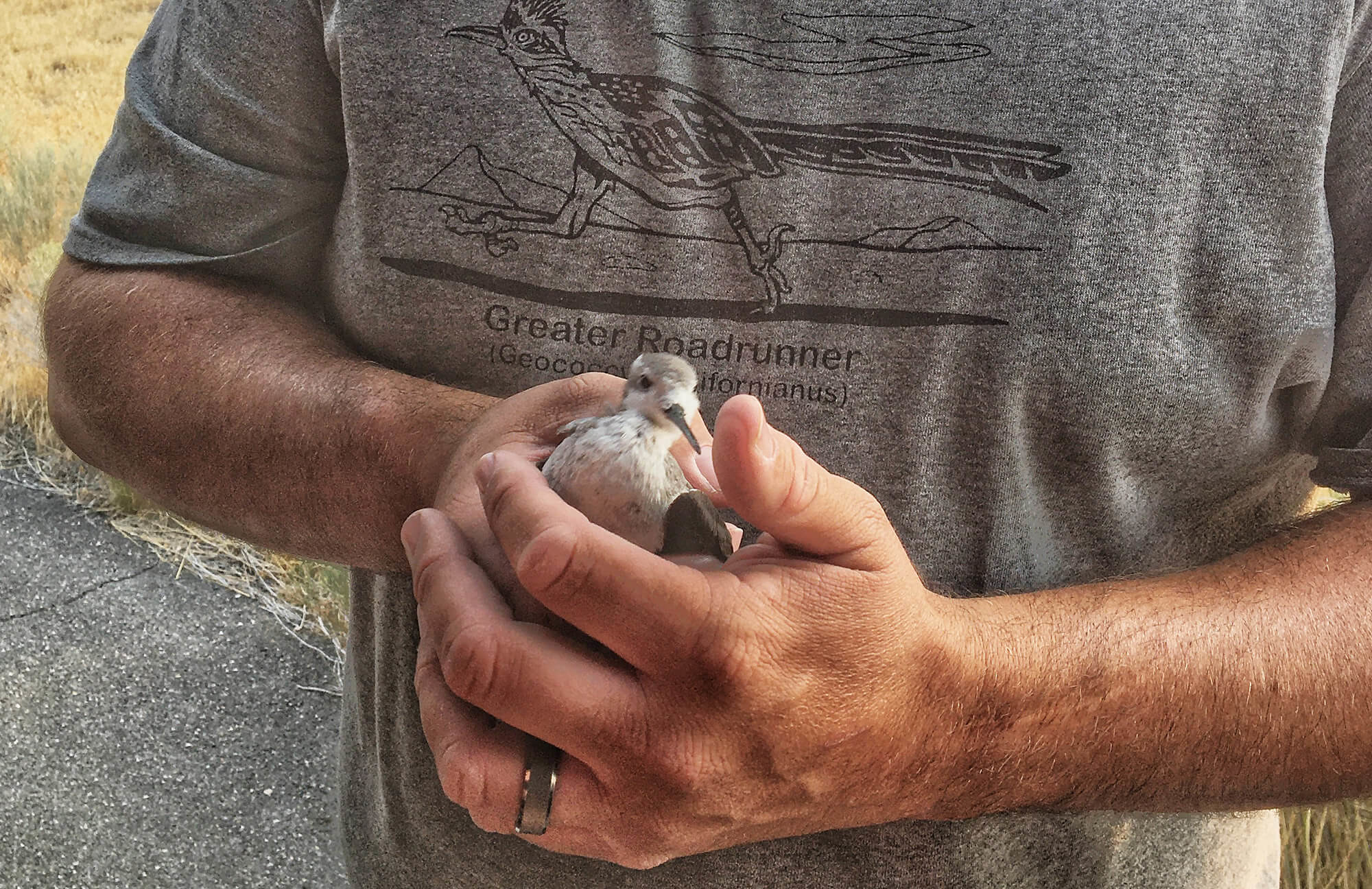 Wilson's Phalarope
Wilson's Phalarope relocation
Aside from the Chukar we found our usual Rock Wren, and a single Burrowing Owl. There were a whopping
8 Sage Thrashers out and about at various stops as well. As we were driving our loop around the island we spotted a
Wilson’s Phalarope in the road. It appears to have a slightly doomed wing. I got out and approached and was able to corral the bird. We transported ti to the causeway and let it go at the water edge. At least here it had a chance to find food before it was likely predated or run over on the road.
We hurried back to the island and picked up
Great Horned Owl before finding a big family group of
Burrowing Owls. We spent some time enjoying watching the owls as they were quite cooperative and close for great views.
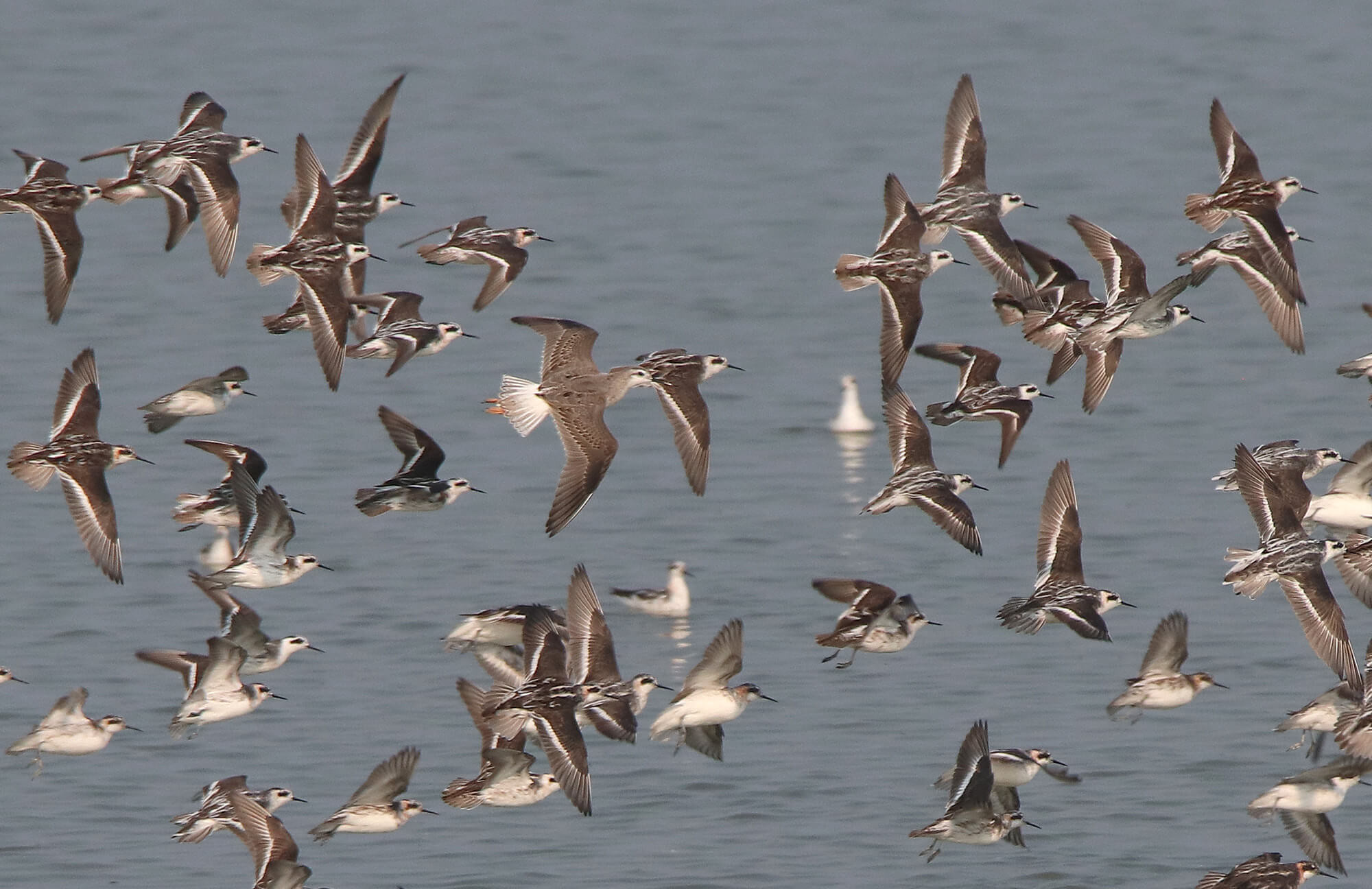 Red-necked Phalarope
Red-necked Phalarope flock... with 1
Wilson's Phalarope
Back on the causeway and making our way out of the park we encounter good numbers of phalarope. Roughly
10,000 Wilson’s Phalarope and
40,000 Red-necked Phalarope in tight flocks on the shallow water. Picking through the shorebirds we found
5 Wester Sandpiper, a single
Baird’s Sandpiper, a
Lesser Yellowlegs,
2 Spotted Sandpipers,
1 Long-billed Dowitcher,
2 Long-billed Curlew, and a handful of
Willet. It wasn’t the most diverse shorebird list, but a good start. We also had nice looks at a few of the
5,000 Eared Grebe present.

A lovely
Clark's Grebe
With the entire day ahead of us we headed to Bear River Migratory Bird Refuge and drove the auto tour loop. The refuge was in a sad state, as the drought had dried up most of the ponds and canals. In just over an hour we still managed around 40 species with great looks ad huge numbers of
Western Grebe and
Clark’s Grebe on the main impoundment which still had water.
Various waterfowl, waders, and divers were all present here including
American White Pelican,
White-faced Ibis, and
Caspian Tern. For me, the highlight was a pari of
Solitary Sandpiper. We see these every once on a while on our Most Wanted Tours as they migrate south for the fall, but by no means is it expected on most tours. We wrapped things up at the refuge, grabbed lunch and hit the road to Idaho. We checked into our hotel in late afternoon and took a short break before dinner.
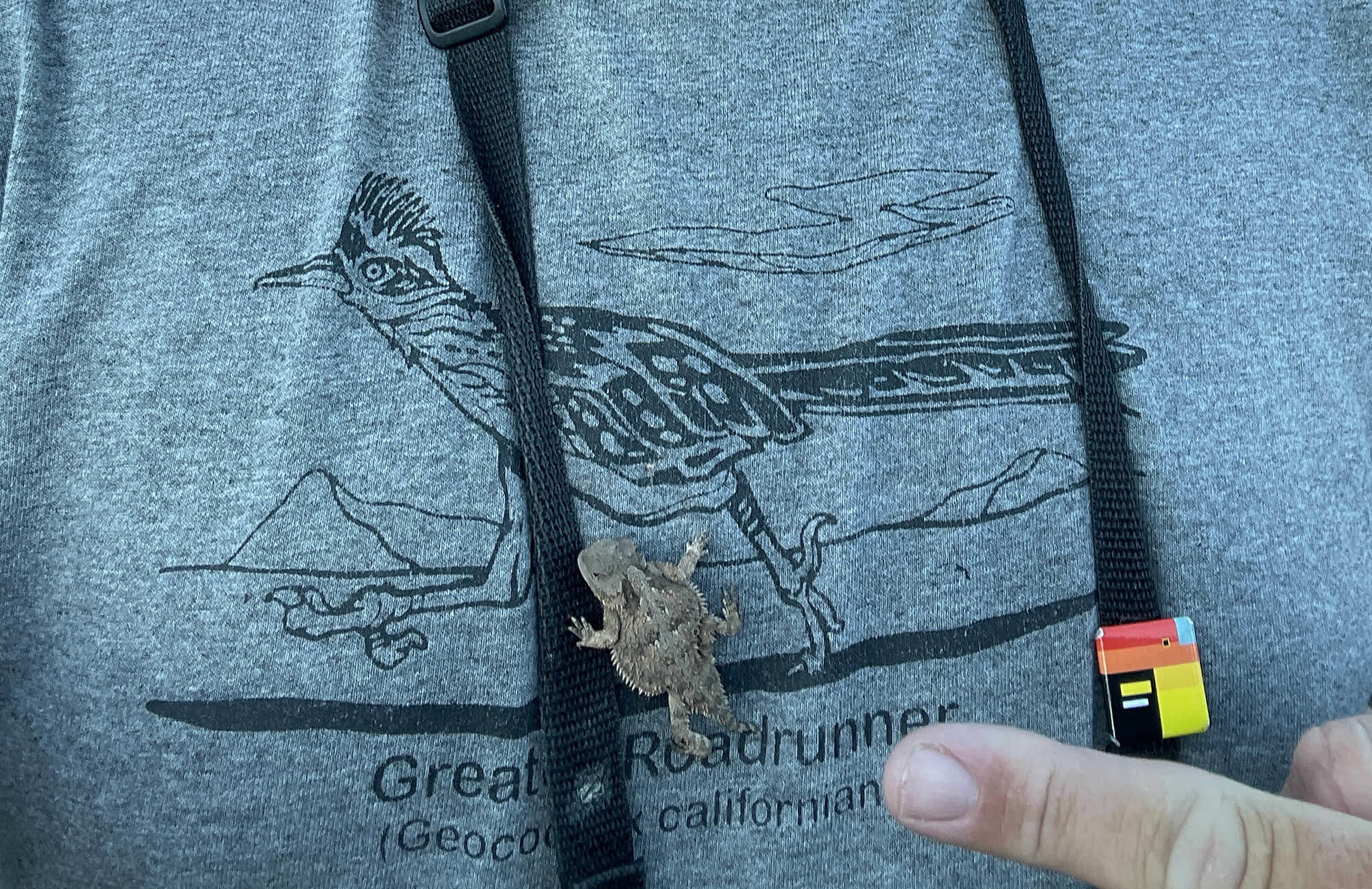
Probably a Pygmy
Short-horned Lizard
After grabbing dinner we headed towards the South Hills. The plan was to maybe get an evening look at Cassia Crossbill, and hopefully track down a cooperative Flammulated Owl after dark. We arrived at Diamondfield Jack Campground at 7:00 pm and spent the better part of the next 2 hours wandering the trails through the forest. We hiked to a Ridgeline I hadn’t visited before, and the Tennessee Tech duo uncovered a Horned Lizard under a rock. After some discussion and consulting the interwebs we settled on
Pygmy Short-horned Lizard. A first on a tour!

Some species of
"Evening Bat" in the South Hills
We picked up many of the typical species here like
Western Tanager,
Brown Creeper,
Hairy Woodpecker, and
Violet-green Swallow. And while we had short looks and flyover
Cassia Crossbill calling, we would return the next day for better views. As we got back to the parking area, several
Common Nighthawk were flying around as well as a number of large bats. Based on the photos I took I'm still not sure of the species, though I suspect they were Big Brown Myotis.

Stunning views of a
Flammulated Owl
As darkness settled I got a little concerned. There was some sort of concert happening at Magic Mountain Ski Area and the speakers could be heard for miles away—would this undo our owling??? My fears quickly evaporated as the road I had been using all summer here worked wonders as we tracked down 2
Flammulated Owls. The second bird being nothing less than a perfect subject to watch and photograph! By 11:00 pm we were back at the hotel for the night!
 Barn Owl
Barn Owl to start the morning off
We kicked off the day visiting the agricultural areas south of town. Despite spending almost 2 hours on the backroads here we had no luck with Gray Partridge—a common theme for the summer of 2021 where we were 3 for 6 here. Prior to this year we had gotten this species on every tour to Idaho with the exception of our first trip when it wasn’t a focus. As a consolation we had an incredible
12 Barn Owls at one of our regular stakeouts..

Gorgeous
Great Horned Owl
There was also a Great Horned Owl hanging out in the same patch of trees and nearby
3 Burrowing Owls were at one of their usual burrows. Several of our Southern Idaho targets were present in good numbers with
30 Western Meadowlark,
20 Swainson’s Hawks, and
5 Northern Harrier. We also tracked down
Sage Thrasher,
Vesper Sparrow,
Loggerhead Shrike, and a single
Brewer’s Sparrow. Incredible numbers of doves were present near the municipal airport where we tallied
28 Rock Pigeon,
14 Eurasian Collared-Dove, and
125 Mourning Dove!!!
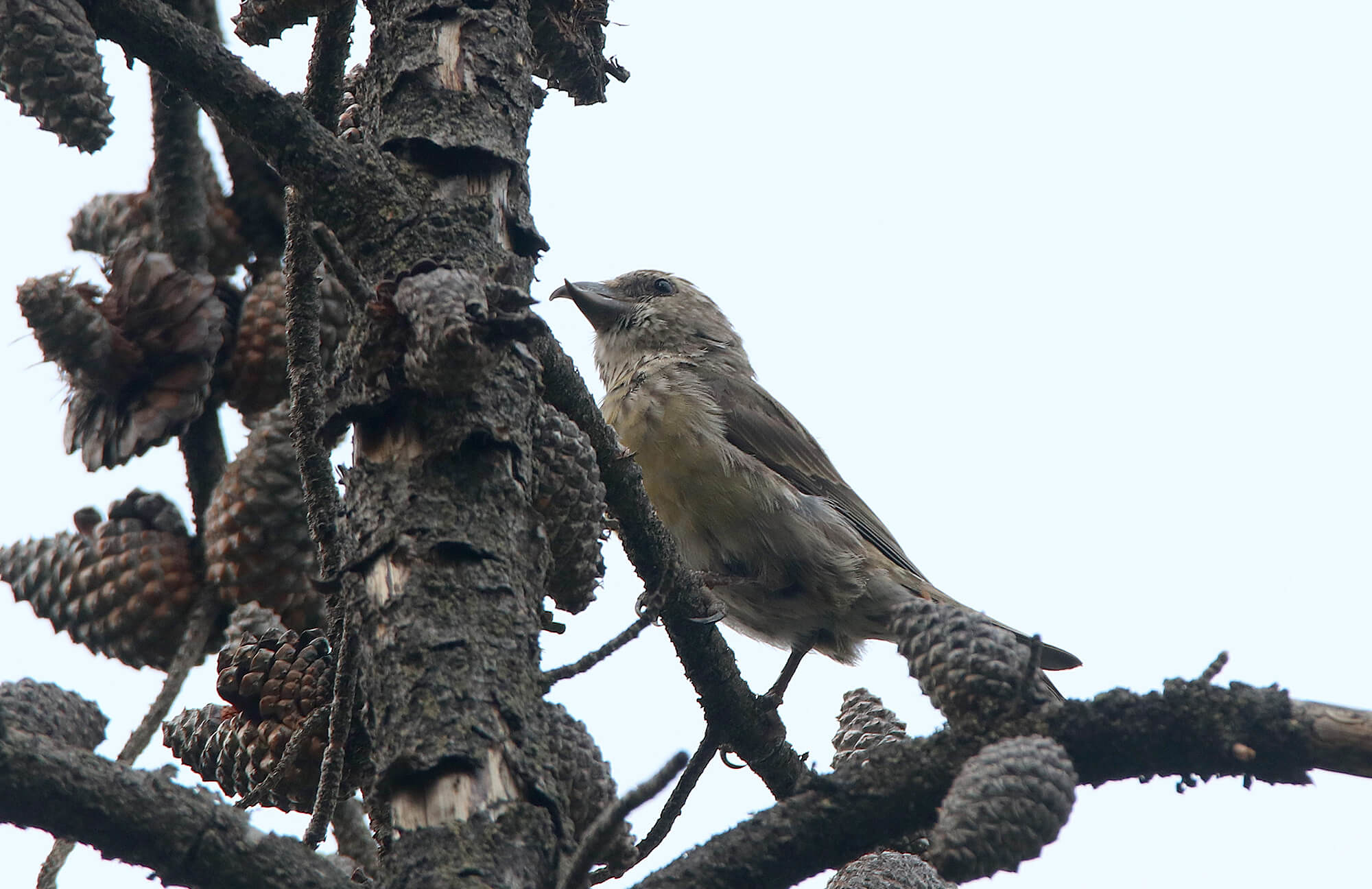
One of the cooperative
Cassia Crossbills
We finally made our way up into the South Hills again, this time to focus on finding the endemic
Cassia Crossbill. Walking the same trail as the previous day our luck was much improved when a flock of birds flying over calling had a few individuals come into trees and spend a decent amount of time perched out in the open for great views and photographs. We were able to put scopes on the birds in several spots allowing lots of time to study and enjoy this interesting species.
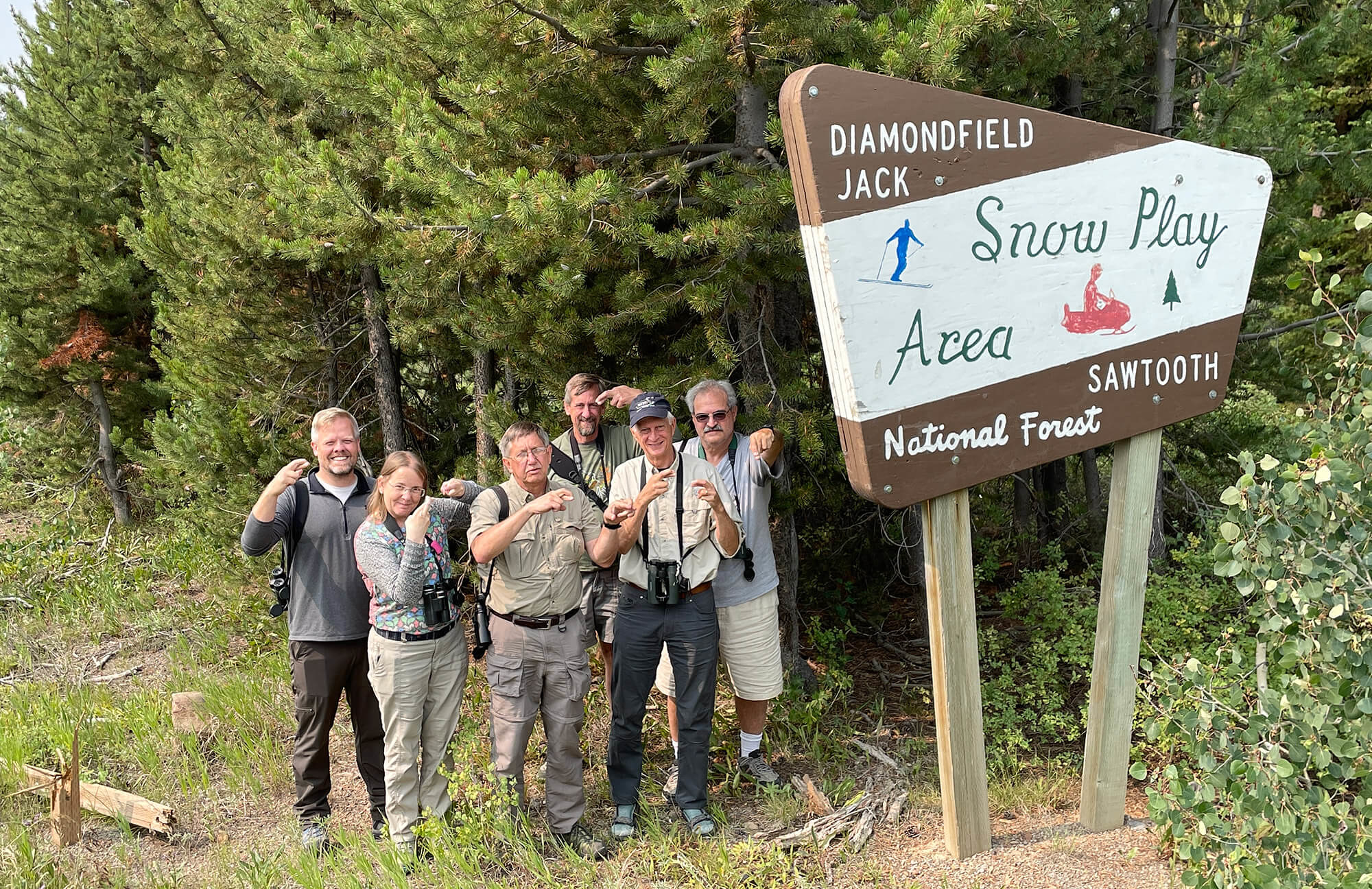
Crossbill Success!
We ventured across the range, finding
4 Lewis’s Woodpeckers along the Burn trail. This location was incredibly quiet. With the early spring and hot summer we had the common theme at the end of July and beginning of August was that most of the breeders were quiet, and many species were much harder to track down. Continuing towards Brockman’s we added
Mountain Bluebird,
Cedar Waxwing, and
American Kestrel for the day.

A very early migrant
Merlin—a first on this tour.
As we pulled into the area near the feeders there was a small raptor perched on a dead snag in the distance. I dismissed the bird as a Sharp-shinned Hawk initially. Luckily the bird took flight and Lyle (form Michigan), said it looks like a
Merlin. Sure enough as soon as the bird started sprinting it was apparent that it was indeed a Merlin! An early migrant and firs for this tour!

A young
Calliope Hummingbird
Brockman’s was nothing less than a zoo on this morning. This summer that had also been a common and unusual theme—one reason we rearranged our tour dates for 2022, to try and make sure we visited any day but a weekend! We drove to the secondary feeder site and ran into several local birders. We spent the first bit here and then once the crowds moved on headed to the main feeders. The entire production was fabulous as usual. We estimated around
20 Black-chinned Hummingbirds were running the show, while a pair of young
Calliope Hummingbirds joined the handful of
Rufous Hummingbirds and
Broad-tailed Hummingbirds also present.
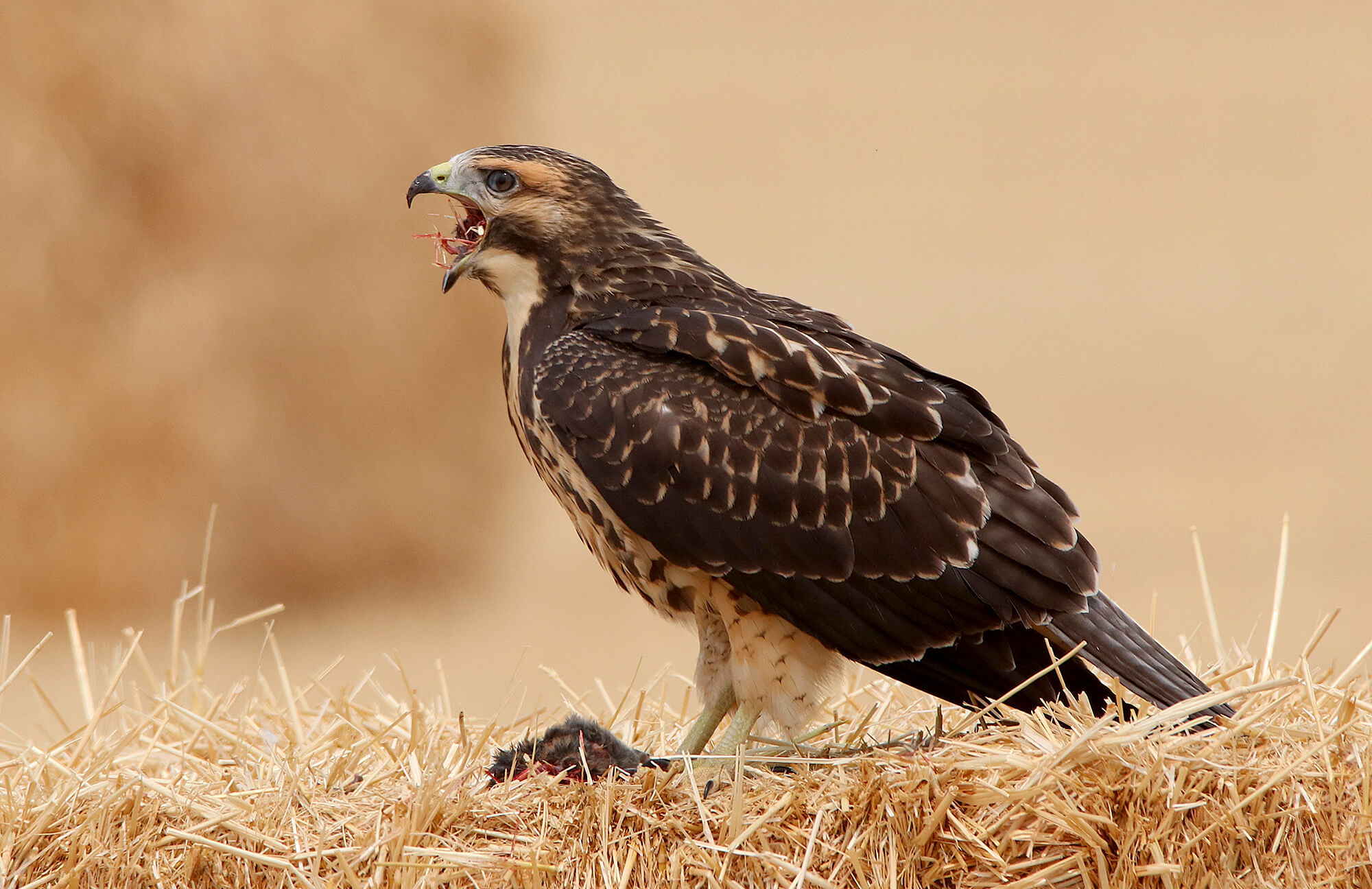
Mmmmm! Lunch! This
Swainson's Hawk was enjoying it!
After a picnic lunch, we headed back towards Twin Falls, again driving the southern fields hoping for some Gray Partridge luck. While that didn’t happen we found a hatch year
Swainson’s Hawk at a buffet on a hay bale. I am 90% sure this was the
same young bird from our Georgia Audubon Tour earlier a few weeks earlier, sticking really close to its nest. We watched as the young bird shredded its prey, and then took the fleshy parts and devoured them. It was both disgusting and incredible to watch and provided an awesome photo op!

Digiscoped
Baird's Sandpiper in Idaho
We took an afternoon break before driving out towards the town of Hansen and a flurry of eBird pins on what appeared to be a couple of holding ponds on a a farm. Sure enough we found two ponds with extremely low water, covered in waterfowl and shorebirds. Despite years of tours here during the summer shorebirds and other waterbirds were always a hard get—but not today. We spent an hour scanning to find anything out of the ordinary. 13 species of shorebird were highlighted by
1 Semipalmated Sandpiper,
3 Baird’s Sandpiper,
175 Western Sandpiper, both
Wilson’s Phalarope and
Red-necked Phalarope, and both
Greater Yellowlegs and
Lesser Yellowlegs.
Waterfowl wise we saw huge numbers of
Cinnamon Teal, and various counts of
Northern Shoveler,
Northern Pintail,
Green-winged Teal,
Redhead,
Lesser Scaup, and several other species. Along the power lines around the ponds were
750 Bank Swallow with
Northern Rough-winged Swallow,
Tree Swallow,
Barn Swallow, and
Cliff Swallow mixed in. We had a 6-species sweep for Idaho all in the same day. These ponds were a major highlight and never on my radar due to their location and the general timing of my tours. I think in the future we might have to take some time to continue to check them out though!
In the evening we decided to try a local park for screech-owl. Surprisingly, the water and traffic noise made it difficult—and the mosquitoes made it almost unbearable to be outside. We did add a
Canyon Wren just before dark, but struck out on owls!

One last group photo at the Cassia County line
Our last morning started off like the previous day in the southern fields. Not much changes overnight as we found many of the same species, but none of the game birds we hoped to target. We checked out of the hotel and made our way over to Shoshone Falls Park where the theme of “quiet” continued. We did track down a couple of
California Quail, one
Lazuli Bunting, and a single
Yellow-breast Chat. We also had both
Canyon Wren and
Rock Wren before wrapping things up and heading back towards Utah. Quick stops in Idaho grand
Great-tailed Grackle in Burley, and an
Osprey in Idaho along the Snake River.
 Sora
Sora peeking back at us
Back in Utah mid-afternoon we headed to Farmington Bay WMA to see if there was anything else new we could add before wrapping things up. We added
Neotropic Cormorant,
Wood Duck,
Sora, and
Virginia Rail for the week, and had a decent number of birds despite the hot August day. And just like that our 10th Most anted Tour came to an end. Despite the disappointment about being able to go to Nevada and track down Himalayan Snowcock, we made the best of the week and still tallied 148 species. A very good number for 4 days of birding here in late July or early August. I offered for the entire group to join me the following summer on one of our future tours as tagalongs so they have an opportunity to see their lifer snowcock. We’ll be seeing them this July and August when we are back at it!
Photos from this Tour:
Birds Seen on this Tour:
Labels: Calliope Hummingbird, Cassia Crossbill, Flammulated Owl, hawks, Idaho, owls, phalarope, utah, White-winged Crossbill

2020 Flammulated Owling Season Recap
Posted: September 03, 2020
May 11 - August 18, 2020 - From Salt Lake City, Utah
If there was one thing about the summer of 2020 that was normal—it was the reliability of Flammulated Owls in the mountains just outside of Salt Lake City. While we had a big summer full of tours planned, I ultimately pulled the plug on almost everything except the Flammy tours. The reason was simple—I could meet my clients in the field, distance, and wear a mask, while still sharing these incredible creatures with the world. There were some caveats though. I didn’t have any large groups. I think the biggest was a family of 5 that came with me in May. Other than that most of my parties were parties of 2 friends or family or individuals. It made the tours simple but meant I still ended up doing a fair amount of owling tours.
Flammulated Owl from a May tour in southwest Utah
Let’s start with the basics. In all, I led 18 Flammulated Owling Tours this summer. Several were part of private tours booked as part of bigger itineraries, while the majority were those small private individual tours. During those 18 tours, we saw or heard a total of 130 Flammulated Owls. A lower count than most summers, but quite often the looks were so good early on that we didn’t keep owling later into the night.
This Flammulated Owl from early June was incredibly cooperative
In all, I found owls in 7 different canyons this summer. These canyons mostly are in 3 larger areas that I split my tours evenly between based on time of the season, day of the week, and making sure that I try to spread out tours to keep the experience fantastic for everyone that comes. How do I do this? I most cases every tour visits a different set of trees or patches of forest within these larger areas. This means that on almost every tour, the birds we encountered haven’t been interacted with this summer—at least by me. This gives every group a chance to see owls that aren’t being harassed week in and out like some local birders and photographers, and tour leaders elsewhere do.
Even ad July wore on the Flammulated Owls were still giving great looks
I also did a quick private owling tour in Washington County that included some diurnal owling. This tour in late May over the course of 2 days produced 7 Flammulated Owls, as well as Barn Owl, Burrowing Owl, Great Horned Owl, Western Screech-Owl, Long-eared Owl, Common Poorwill, and Lesser Nighthawk.
Not a flammy! This Long-eared Owl was found during our May tour in southwest Utah
Most of these birds would normally be seen on my Birding Zion Tour in early May, but it was canceled—at least going forward we have a nice variety of owls to look forward to here! Back in the north, I ran 3 tours in May, 4 tours in June, 6 tours in July, and 4 more in August. Our biggest night was 12 Flammulated Owls on May 26th, followed by 11 on June 4th. We averaged just over 7 Flammy’s per tour this year.
One of my favorite shots from the summer was this mid-May Flammulated Owl
In mid-July, while checking old nest cavities I located an active Flammy nest and watched it for several days. It was the only active nest I located this summer, despite checking nearly 20 cavities from previous years. The status of the active nest is unknown though—as about a week later I observed a Northern Flying Squirrel emerging from the cavity. It was definitely late enough for the birds to have fledged, and I really hope that happened before the squirrel took over!
The Northern Flying Squirrel that moved into this Flammy nest
I ran a late tour on August 18th and we still were seeing owls with relative ease. At this point, most of the birds we saw appeared to be younger, and in almost every case were calling independently when located. Testing out those vocals and making some odd calls for sure!
The last Flammulated Owl of the year--a recently fledged bird still growing those feathers
In the end, I look back at the summer of 2020 as another successful season in the books. While overall numbers were down due to fewer tours, the viewing this year was top notch. Active and cooperative birds provided an incredible opportunity to talk about this species with a variety of clients, and in many cases, some of the photo ops were the best I’ve seen. With the 2021 season 9 months away, I hope the world can get back to normal and I can share these incredible owls with even more birders as I enter my 14th summer leading these tours!
Labels: Flammulated Owl, Long-eared Owl, Northern Flying Squirrel, owling, owls, utah

2020 Flammulated Owling Kickoff
Posted: May 19, 2020

Our first Flammy on a tour this year on May 18th.
|
On May 11th the State of Utah opened the highway into our favorite early season owling location, so I decided to get out and see what the habitat looked like and how active the birds were. I left Salt Lake on the 40-minute drive so that I would arrive just as it was dark enough to start owling. I drove to the furthest point in the canyon where I typically find owls and stepped out into the cool night's air.
American Robins and
Hermit Thrushes rang out form the aspen covered hillsides—but more importantly, 3
FLAMMULATED OWLS were calling simultaneously from various directions. The birds were back and extremely active!
It was still a little lighter than I like to start, the mountain tops to the west highlighted by the distant last rays of daylight faded. I decided to give it a try and started calling. A bird bee-lined it past me--the first Flammy of the year. Continuing to talk the bird made its way back and I spotted it come in to land about 50' away on a dead limb. I put the light up and got a quick look at the tiny owl before it fluttered off into the dark. Wanting to give the birds plenty of space, and not harass them, I moved on to my next stop.
Over the course of the next hour I made 4 more stops, and at each location was greeted by calling Flammulated Owls. I broadcast at a couple locations and didn't get much in the way of responses, so I just tallied up what I was hearing and kept moving. At my final stop for the night, there was a very territorial bird who wasted no time in coming in to say hi—it was the 12th Flammy of the night!

|
Our first cooperative owl of the year!
It was a great start to the year. The owls were back, active, and responsive. The only issue was how many people would I be able to share them with this summer due to Covid-19? Fast forward one week to May 18th and I put together a private tour with a family of 5 to go look for owls. There were some differences between my usual tours, however... For starters, I didn't provide transportation—instead, I had my clients meet me near where we would go owling, then follow me in their car. Next, there was to be 6' of space between myself and the group while birding. I could still show them the birds without having to get close. Third, when we got the owls there would be no congratulatory high-fives or handshakes. It was to be a hands-off experience.
With this in mind, we met shortly after sunset and caravanned to the spot I wanted to try for owls. When we got there it was quiet, but a little windy. We gave it some time to calm down then started owling. Right off the bat, we had several birds calling but nothing really responsive. We have parked about a 1/4 mile away and were going to walk our way back looking for birds along the way. At our second stop, we tried and didn't get any response—but just as we were starting to walk away an owl started calling relatively close. The next thing we knew it had flown in and landed low in an Aspen right next to our group. Everyone got a nice short look before the bird departed deeper into the forest. At about the same time, another owl started calling on the other side of the road where we were walking. We moved that direction, and after a short search, I found the bird perched about 15' up on a dead limb. This time the bird sat and watched us as we watched it. For several minutes we enjoyed nice looks as the owl before it took flights and headed back into the forest. The group was pleased and we called it a night, without having to check any other spots for owls. |
Labels: Flammulated Owl, owls, utah

Birding Indonesia Part 5: Flores Endemics
Posted: October 26, 2018
September 11 to 12, 2018
The Chestnut-backed Thrush was a star of the birding on Flores for me
As I've become accustomed to with travel overseas, delays are frequent--so it wasn't surprising that our flight out of Bali to Flores was delayed more than 90 minutes. We eventually boarded a stuffy plane, with an extremely narrow pitch--my knees wouldn't have made it if it weren't for having a toddler next to me. The flight was under an hour, and we thudded into Labuan Bajo with a landing fit for no plane--seriously the plane lurches left and right when the wheels touched, for a brief moment inducing the thought, "are we about to crash?". We didn't. I really like regional airports in small cities--and this one was no exception--the signage facing the runway read
K O M O D O in big block letters, and there was a dragon motif on the exterior of the building to go along with it.
Komodo Airport in Labuan Bajo
Even on the otherside of the world, the font Papyrus haunts me..
We grabbed our bags and quickly found that our ride was not waiting for us--in this case, the 90-minute delay was to blame. We snagged a taxi and were at the Puri Sari Beach Resort 10 minutes south of town before sunset. We walked out to the beach and enjoyed the last few minutes of light before it faded to pink then dark.
Sunset on the beach
A few minutes later from our room...
Before coming to Flores I reached out to a guide who agreed to set up our boat tour to Komodo National Park, and could also help with birding in Flores. My main focus on the island were the 3 scops owls, and a handful of endemics that I figured I could get with a 1/2 day tour and a couple nights of owling. As it would turn out our guide, Max Wago would not be able to take us on our trip. He claimed to have tonsilitis and instead would send us with another guide. Everything would work out in the end, but the birding was nearly 100% self-guided in a place I would have really liked to have had a guide. The truth is, I should have planned better and could have probably avoided any issues.
So the following morning Max arranged for a driver to pick me up at 4:00 am and head into the mountains to look for owls. The driver knew the rough areas to stop, but I would have to try for the birds on my own. As luck would have it, we didn't have to go far before a
MOLUCCAN SCOPS-OWL flew across the road just outside of town. Despite my best efforts, I couldn't coax the bird into the open. At our first actual stop I got out the car to a calling
MEE'S NIGHTJAR--formerly a subspecies of the Large-tailed Nightjar, this species has a significantly different call. Like the owl, the nightjar didn't care about my playback and we moved up in elevation.
The next several stops turned up exactly ZERO owls or nightjars of any kind. The frustration of not knowing an area and where the birds are. As we reached the elevation where Flores and Wallace's Scops Owls overlapped my driver pulled over and made a comment about the spot being good for owls. Out of the vehicle, I immediately heard a calling
WALLACE'S SCOPS-OWL. I got my gear ready and headed in the direction of the sound. For the next few minutes, the bird and I played phone tag, until the bird eventually flew right at me, passing just a couple feet above my head and gliding up the hill behind me into a tree. Despite following it with the spotlight, I couldn't pick it out in the large tree, and subsequent attempts to coax it out failed.
I was slightly frustrated, but we still had time to try for Flores Scops Owl. Had I done better research before,I would have had the driver take me to the trail we would end up birding later in the day, and I would have just hiked through the jungle trying for the bird. Instead, we tried again on several small side roads. Again, the first few stops were void of owls--but on the third try a bird, a
FLORES SCOPS-OWL immediately responded to the playback. But like the other birds, it refused to cooperate.
Sunrise from a moving car over Flores...
The morning would go down with 2 flyby owls, a 3 audible, and an audible on the nightjar--how I wish I would have had a couple more days to try again. As the horizon began to lighten to the east, I could make out the mountains I was currently in. We drove down one more road and tried again for the 2 higher elevation owls with no response--and as the sun rose,
ELEGANT PITTA started calling from several locations in the forest around us--the jungle came to life.
We headed towards Puarlolo which from what I can tell is a reserve. I found this description online which is helpful:
This small forest patch lies alongside the main East-West (Ruteng) road around 36 km east of Labuanbajo. It can easily be reached as a day trip from town, or en-route to or from Ruteng. Look out for the birdwatching signs and the obvious telecom tower set just back from the road on the right (as you travel from Labuanbajo). Small trails leave from the clearing in front of the tower, and a more obvious trail descends from the main road a couple of hundred meters back from the turn-off to the tower, around the back of a small building/office.
The forest from the road near Puarlolo
I walked down the trail from the main building into the forest--there were birds making noises all around, and I didn't recognize any of them. The first bird that I spotted was an easy ID as a
FLORES MINIVET. Still too early for photos without a flash, my shots all turned out black. I headed deeper into the forest and got my first look at a
CHESTNUT-BACKED THRUSH, truly a remarkable looking bird--the lighting issue persisted for another 15-20 minutes.
I waited till I felt I could start getting shots of things to keep moving when I heard a call that sounded like a parrot coming from a tree above.
Scanning the tree I spotted a rather drab looking
RED-CHEEKED PARROT. It must have been a young bird. But at least I was able to get a picture!
A young Red-cheeked Parrot without those red cheeks
After a few minutes, I heard an
ELEGANT PITTA calling from what sounded like just a few feet away. So I found a good place to sit down where I was mostly surrounded by tall grass and I tried to lure it into the open. The call got so close I felt like the bird was a foot away, but I couldn't' see it anywhere.
I strained my eyes on the forest floor scanning every stick, rock, limb, flower, and leaf. Nothing. The bird sounded as if it were maybe 6-10' above me, but why would a pitta be up in a tree I thought... So I never looked--and I never saw the bird that spent the next 30 minutes calling from everywhere around me. It was maddening.
The trail where I hid looking for the Pitta
I later in the day learned that while the Elegant Pitta is terrestrial like most other pittas, it is also quite adept to displaying anywhere from 10-30' off the ground, in the trees. The bird was above me, and I had failed to scan where it was likely sitting because of a preconceived an incorrect notion that pittas are always found in the understory! But the wait did turn up several
CHESTNUT-BACKED THRUSHES, of which I was able to get decent shots.

These Chestnut-backed Thrushes really are gorgeous birds
It also turned up a number of other birds like calling and endemic
WHITE-THROATED KINGFISHER and
FLORES CROW. A pair of
RUDDY CUCKOO-DOVE made a short appearance before they realized I was watching them and flew off back into the jungle.
A very grainy shot of a Ruddy Cuckoo-Dove
GREEN JUNGLEFOWL and
BROWN QUAIL called from the jungle, while a
VARIABLE GOSHAWK burst into chatter from somewhere nearby. There was so much audible stimulation, but the visuals were far and few between...
I started hiking down the trail to see if I could eventually find some more birds to look at when I got into a small flock of birds moving along together. There were
BARE-THROATED WHISTLER and
RUSTY-BREASTED WHISTLER--I could hear male birds singing further back from the trail, but only female birds out in the open.
Female Rusty-breasted Whistler (probably)
Female Bare-throated Whistler (probably)
RUSSET-CAPPED TEPIA and
SPECTACLED MONARCH passed by too quickly for photos, leaving me photographing a small yellow and brown bird that I couldn't figure out. The bird was a
DARK-CROWNED WHITE-EYE--but it looked, unlike any white-eye I'd seen before.
Dark-crowned White-eye look nothing like other white-eyes in my opinon
I spotted a thrush jumping up the trail--only this one wasn't the more common chestnut-backed--it was a
CHESTNUT-CAPPED THRUSH, and by the time I pulled my camera up, it disappeared into the understory. I only had till about 8:00 am before I had to leave to get back to Labuan Bajo by 9:00 am. So I painfully pulled myself away from the birds to start heading back. I spotted a drongo, the endemic
WALLACEAN DRONGO, and got some crappy shots through the forest.
Wallacean Drongo hiding in the jungle
As I got closer to the trailhead I spotted a gray, white and black bird skulking through the trees--I was fairly certain it was a
FLORES MONARCH, but it was staying well out of view. finally, it lit on a small cross branch in a rather dark patch of trees, and I got the full view of the bird--it was the endemic monarch, and I managed a decent shot of it before it disappeared back into the thick.
The endemic Flores Monarch
There was a surprising amount of activity in the patch of forest closest to the road, including several more drongos, and a small group of the
RED-CHEEKED PARROTS, including a lovely adult male with the colors I had been expecting to see.
Red-cheeked Parrots, how I expected them to look
My time was up and I had to get back to Labuan Bajo. I wish I had had several more mornings, even if just to visit this same patch of forest over and over--it was fantastic. I recorded a lot of things that frankly I haven't even tried to listen to or ID since getting back. At some point hopefully, I will be able to match some of the recordings that I didn't know with some of the birds I do!
Loved this forest at Puarlolo
We descended from almost 3,000' back to sea level, giving me a whole new appreciation for where we had driven in the dark. Flores, is an interesting place and has enough endemic birds, that is it worth several days to cover the whole island. Unlike Bali, it is not a major tourist destination, with the vast majority of westerners never going east from town. Even as I sit here on the other side of the world, the one thing I wish I had done while on this trip would have been one more entire day of birding with a guide--while I racked up nearly 25 lifers on Flores, I probably could have probably tripled that with a proper guide!
Driving back to Labuan Bajo
The driver dropped me off, and I had breakfast with Cam and Sam, before setting off for town to try and get some cash and supplies for our boat trip. Labuan Bajo is truly a dusty frontier town--it's prominence on a map is 100% due to Komodo National Park, and surprisingly no one has really taken hold of that and done something amazing with the area. Everything feels very much like you are stepping back in time technology and modernity it wise. And I like that.
The main drag through Labuan Bajo
I met with our new guide, Jack, and squared away all the details for the following 3 days--tomorrow we were boarding a live-a-boat where'd we sleep for 2 nights, and live for 3 days. There would be snorkeling, birds, and Komodo Dragons, and it would pan out to be an incredible experience...
Photos from These Days
From Puarlolo
Checklists from These Days
Puri Sari Beach Hotel (9/11)
Puarlolo
Puri Sari Beach Hotel (9/12 morning)
Puri Sari Beach Hotel (9/12 afternoon)
Other Posts in this Series
Indonesia Part 1: Via Hong Kong
Indonesia Part 2: Nusa Dua Lagoon
Indonesia Part 3: Sebatu and Ubud
Indonesia Part 4: West Bali National Park
>>Indonesia Part 5: Flores Endemics
Indonesia Part 6: Komodo National Park
Indonesia Part 7: Recap & LogisticsLabels: Asia, Bali, endemics, Flores, jungle, Komodo, national park, owls, pittas

 BACK
BACK







































